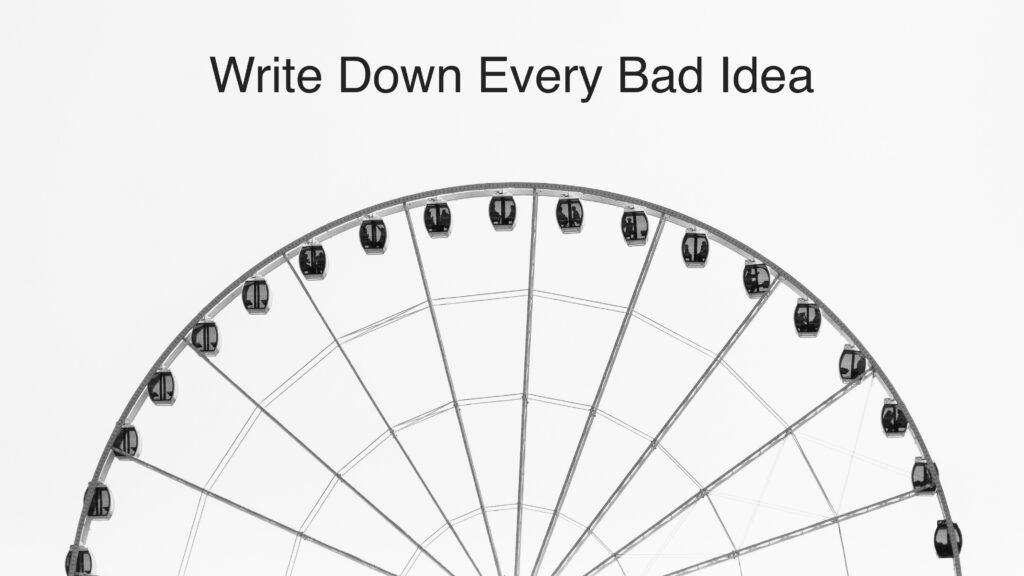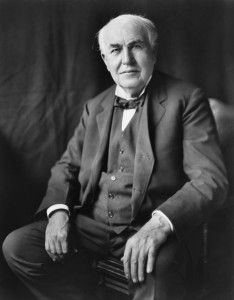
Most of Thomas Edison’s ideas were bad.
At least they weren’t good enough to make it out of the laboratory. Or from the patent office to the product line. Thousands of ideas, never to see the light of day.
An associate of Edison’s, Walter S. Mallory, recalled asking the inventor about this, according to a 1910 biography “Edison: His Life and Inventions.” Mallory recalled that Edison had been working for months on a nickel-iron battery. Mallory visited Edison in his shop and learned his friend had tried more than 9,000 experiments for the battery and none had been successful.
“In view of this immense amount of thought and labor, my sympathy got the better of my judgment, and I said: ‘Isn’t it a shame that with the tremendous amount of work you have done you haven’t been able to get any results?’”
Mallory sympathized with Edison. He felt sorry for him that so many ideas had not yet produce one result. Edison saw it differently.
“Edison turned on me like a flash, and with a smile replied: ‘Results! Why, man, I have gotten a lot of results! I know several thousand things that won’t work.'”
More ideas are good ideas
Edison’s story illustrates a principle that some of the most successful people and companies in history have long known. If you want to have good ideas. You’re going to need a lot of ideas. Even bad ones.
Especially bad ones.
Author and Entrepreneur Frans Johansson discusses this in his book “The Medici Effect: Breakthrough Insights at the Intersection of Ideas, Concepts, and Cultures.”
““The strongest correlation for quality of ideas is, in fact, quantity of ideas. A closer look at the number of new products, songs, books, scientific papers, strategy concepts, ideas, ideas.”
For example, he writes, many teams will generate ideas in the thousands knowing that more than 99 percent will never be touched. Those bad ideas aren’t wasted time. They serve the greater purpose.
“Some individuals or creative teams will come up with ten, a hundred, or even a thousand times more ideas than their peers,” Johansson wrote. “Not only that, those who have created the most are also the ones who have the most significant innovative impact. This was true in the past; Pablo Picasso, for instance, produced 20,000 pieces of art; Einstein wrote more than 240 papers; Bach wrote a cantata every week; Thomas Edison filed a record 1,039 patents. This holds true today. Prince is said to have over 1,000 songs stored in his secret ‘vault,’ and Richard Branson has started 250 companies.”

In Google’s early years, the company’s astronomical growth was due in part to the huge volume of ideas all of its employees were generating.
If you wanted to work at Google, you had to be an idea machine.
The company maintained an ideas e-mail list where anyone could submit or comment on an idea.
“At times, the thread more resembles a form of techie Darwinism. Google newcomers who proffer an especially obvious suggestion …, or something off-topic like how to arrange the cafeteria tables, often suffer withering rebukes,” reads a 2005 Bloomberg Business article on the company and then-executive Marissa Mayer, who today is President and CEO of Yahoo.
“It’s about 50% new ideas, 50% indoctrination of new employees,” Mayer said of the e-mail list.
Or as Linus Pauling, chemist and winner of two Nobel Prizes, put it: “The best way to have a good idea is to have a lot of ideas, and throw away the bad ones.”
The science of bad ideas
There is science to support the art of bad ideas.
Researchers from the University of Pittsburgh, Carnegie Mellon and the University of Texas-Austin found that a larger variance in the quality of ideas leads to more positive progress generating high-quality ideas. In other words, the more your ideas pool includes a mixed bag of ideas — good, bad and mediocre — the more likely you are to stumble upon a great idea.
If you strain over every bad-seeming idea and try only for ones that seem world class from the beginning, you’re hurting your progress.
Researchers from the Wharton School and INSEAD studied idea generation in research subjects organized into two groups. They found that the group that produced more ideas also produced better ideas.
How to have more ideas
Now that you — hopefully — believe in the power of bad ideas, it’s time to learn how to put them into practice. To put more ideas out into the world, you might have to start by taking more in.
Read
As Y Combinator cofounder and partner Paul Graham put it, read more. Keep an eye out for problems in the world that need addressing.
“Reading the Wall Street Journal for a week should give anyone ideas for two or three new startups,” Graham has wrote. “The articles are full of descriptions of problems that need to be solved.”
Write
Get your ideas recorded. It sounds simple, but something as easy as a “bad ideas” file in Evernote or Trello could serve as a clearinghouse for your ideas. Let the ideas sit for a while, then revisit them days or weeks later. If you record enough ideas, many you may not even remember writing. It will give you a fresh perspective, and you’ll feel confident moving some ideas over to a file called “maybe OK ideas.”
Work Alone
It may seem counterintuitive — especially if you have bosses eager to cram everyone into a conference room to scribble ideas on a white board — but working alone on generating ideas could be more effective than working in groups.
The Wharton School and INSEAD researchers studied idea generation in subjects who were placed into two different group. One group worked as a team, the second worked in a hybrid structure, working first individually and then in a group setting.
The hybrid group performed much better than the group that worked only as a team.
“We find that groups organized in the hybrid structure are able to generate more ideas, to generate better ideas, and to better discern the quality of the ideas they generate,” the researchers wrote.
Furthermore, the researchers found that the group brainstorming session may actually inhibit productivity.
“Moreover, we find that the frequently recommended brainstorming technique of building on others’ ideas is counterproductive; teams exhibiting such buildup neither create more ideas, nor are the ideas that build on previous ideas better.”

Grind it out
It’s important to keep hustling when it comes to generating ideas. It’s not about the quality of any one idea, it’s about trusting the process.
If that seems difficult, remember that you’re in good company.
“Painters, musicians, entrepreneurs, writers, chiropractors, accountants–we all fail far more than we succeed. We fail at closing a sale or playing a note. We fail at an idea for a series of paintings or the theme for a trade show booth,” wrote bestselling author Seth Godin in a blog post.
“But we succeed far more often than people who have no ideas at all.”
Don’t be a person with no ideas. Get your thoughts out there. Even the bad ones. If you trust this process, things will come together.
Something good will happen.
P.S. If you liked this article, you should subscribe to our newsletter. We’ll email you a daily blog post with actionable and unconventional advice on how to work better.
